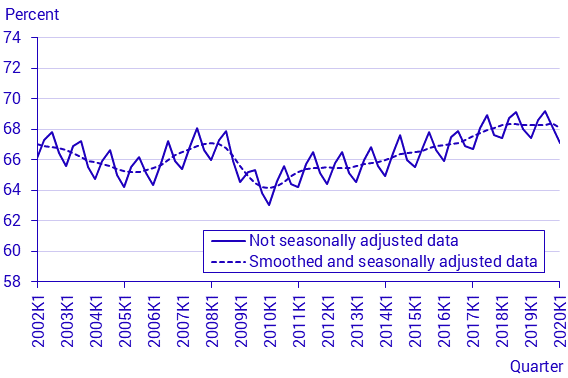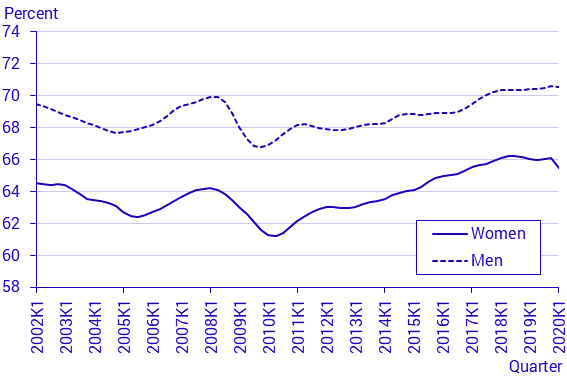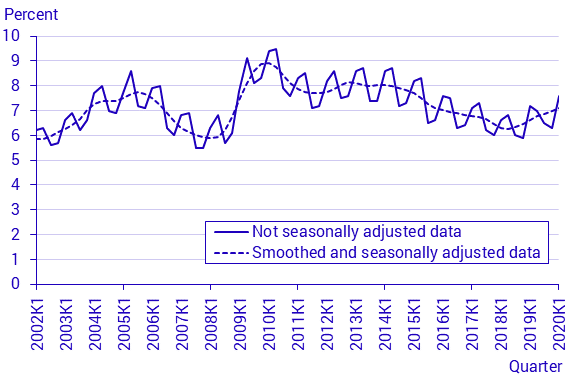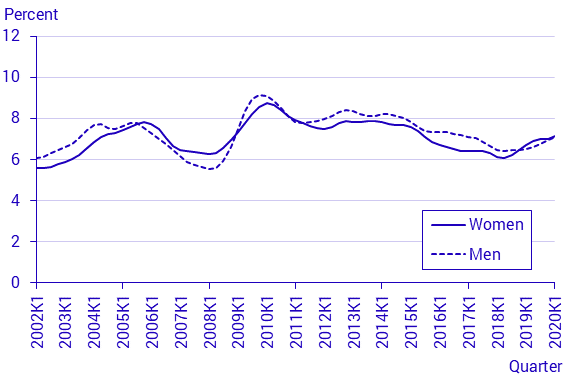Labour Force Surveys (LFS), 1st quarter 2020
Long-term unemployment increased
Statistical news from Statistics Sweden 2020-05-07 9.30
The share of employed persons aged 15-74 in the first quarter of 2020 was 67.1 percent and the unemployment rate was 7.6 percent, non-seasonally adjusted. The number of persons who were in long-term unemployment increased compared with the corresponding quarter a year ago. The average number of hours worked amounted to 155.8 million per week. Seasonally adjusted and smoothed data shows a decrease in employment, while unemployment rose.
The LFS continuously measures the labour market situation during all weeks of the year. For the first quarter, the LFS covers the period from 30 December 2019 up to and including 29 March 2020, weeks 1-13. This means that the reference period only covers a short period affected by the effects of the coronavirus outbreak.
Due to the current situation, seasonal adjustment of data for the March LFS included correction for outliers in all series, with the exception of unemployed persons. The effects of the corrections, including level shifts in the trend series, affect seasonally adjusted and seasonally adjusted and smoothed values for the first quarter of 2020.
The labour force
The number of persons in the labour force aged 15-74 years amounted to 5 471 000 in the first quarter of 2020, non-seasonally adjusted. The number of men in the labour force increased by 35 000 and amounted to 2 892 000, and there were 2 579 000 women in the labour force. The relative labour force participation rate was 72.6 percent; 69.7 percent for women and 75.5 percent for men.
Seasonally adjusted and smoothed data shows a decrease in the number and share of persons in the labour force compared with adjacent quarters. In the first quarter of 2020, there were 5 516 000 persons in the labour force, which corresponds to 73.2 percent of the population.
Employment
In the first quarter of 2020, there were 5 056 000 persons aged 15–74 in employment, non-seasonally adjusted. This corresponds to an employment rate of 67.1 percent. There were 2 385 000 women and 2 670 00 men in employment. The employment rate was 64.5 percent for women and 69.7 percent for men.
Seasonally adjusted and smoothed data shows a decrease in both the number and share of employed persons compared with adjacent quarters. In the first quarter of 2020, there were 5 124 000 employed persons, which corresponds to an employment rate of 68.0 percent.
Employees
In the first quarter of 2020, there were 4 547 000 employees, non-seasonally adjusted. Among those, 2 250 000 were women and 2 297 000 were men. There were 3 851 000 permanent employees. Among permanent employees, 1 870 000 were women, and 1 982 000 were men. There were 696 000 temporary employees, of whom 380 000 were women and 316 000 were men.
Hours worked
The total number of hours worked averaged 155.8 million per week, according to non-seasonally adjusted data for the first quarter of 2020.
Seasonally adjusted and smoothed data shows a decrease in the number of hours worked. In the first quarter of 2020, the number of hours worked averaged 152.5 million hours per week.
The majority of employed persons have an agreed working time of 35 hours or more per week, that is, full-time work. In the first quarter of 2020, 3 922 000 persons worked full time, of whom 2 253 000 were men and 1 669 000 were women. In total, 354 000 persons worked short part-time (1–19 hours) and 761 000 persons worked long part-time (20–34 hours).
The average actual hours worked among employed persons aged 15–74 years amounted to 30.8 hours per week in the first quarter of 2020. This is 1.0 hours less than in the first quarter of 2019. Women worked 28.3 hours, a decrease of 0.9 hours, and men worked 33.1 hours, a decrease of 1.0 hours.
Underemployment
Among employed persons aged 15–74, 287 000 were underemployed in the first quarter of 2020. Among underemployed persons, 147 000 were men and 140 000 were women. Underemployed persons accounted for 5.7 percent of employed persons.
Unemployment
In the first quarter of 2020, there were 415 000 unemployed persons aged 15-74, non-seasonally adjusted. This corresponds to an unemployment rate of 7.6 percent. There were 193 000 unemployed women and 222 000 unemployed men. The unemployment rate amounted to 7.7 percent among men and 7.5 percent among women.
Among persons aged 15–74, seasonally adjusted and smoothed data shows increases in both the number and share of unemployed persons, compared to adjacent quarters. In the first quarter of 2020, there were 392 000 unemployed persons, which corresponds to an unemployment rate of 7.1 percent.
The number of long-term unemployed persons (unemployed for at least 27 weeks) aged 15–74 increased in the first quarter of 2020 by 19 000 to 108 000, non-seasonally adjusted. This number was evenly distributed between men and women, 54 000 each. For women, this was 15 000 more than in the corresponding quarter a year ago.
There were 129 000 unemployed young persons aged 15–24, non-seasonally adjusted. This corresponds to an unemployment rate of 22.4 percent. Among unemployed young persons, 86 000 were full-time students.
Among young persons aged 15–24, seasonally adjusted and smoothed data shows a minor change in the number of unemployed persons and an increase in the share of unemployed persons compared with adjacent quarters. There were 123 000 unemployed persons, which corresponds to an unemployment rate of 20.2 percent.
Not in the labour force
The group 'not in the labour force' includes persons who are not classified as employed nor as unemployed. In the first quarter of 2020, there were 2 061 000 persons not in the labour force, of whom 941 000 were men and 1 120 000 were women.
Among persons not in the labour force, there were 930 000 retired persons. Furthermore, there were 665 000 full-time students and 256 000 persons who reported that they were on long-term sick leave.
Latent job seekers
There were 148 000 latent job seekers aged 15–74 years in the first quarter of 2020. Among young people aged 15–24, there were 80 000 latent job seekers.
Unused labour supply
Unemployed persons, underemployed persons and latent job seekers together comprise the unused labour supply. In the first quarter of 2020, the unused labour supply averaged 19.0 million hours per week, which is 1.6 million hours more than a year ago. The unused labour supply corresponds to 475 000 full-time employments with 40-hour work weeks.
Labour market for persons aged 20-64 years
The population covered by the LFS is comprised of persons aged 15–74 years. However, labour market participation among younger and older in this age group is considerably lower for natural reasons, for example that this group contains large shares of students and retired persons. To better approach what can be seen as the core of the actively working population, the situation of the age group 20–64 years is described in the following section.
The relative labour force participation rate among persons aged 20–64 years amounted to 86.6 percent in the first quarter of 2020, non-seasonally adjusted. For women, the relative workforce participation rate was 83.5 percent and for men it was 89.5 percent. Seasonally adjusted and smoothed data shows a decrease in the labour force participation rate, which amounted to 87.1 percent.
In the first quarter of 2020, the share of employed persons aged 20–64 was 80.7 percent, which is a decrease of 0.7 percentage points, non-seasonally adjusted. For women, the corresponding figure was 77.9 percent, down by 1.2 percentage points, and for men it was 83.4 percent. Seasonally adjusted and smoothed data shows minor changes in the employment rate, which amounted to 81.6 percent.
According to non-seasonally adjusted data, the unemployment rate in the age group 20–64 amounted to 6.8 percent, an increase of 0.7 percentage points. For women, the unemployment rate was 6.7 percent and for men it was 6.8 percent. Compared with adjacent quarters, seasonally adjusted and smoothed data shows an increase in the share of unemployed persons, which amounted to 6.3 percent.
Swedish born and foreign born persons aged 20–64 years
The relative labour force participation rate among Swedish born persons aged 20–64 years was 88.2 percent in the first quarter of 2020, a decrease of 0.6 percentage points, non-seasonally adjusted. Among Swedish born women, the relative participation rate amounted to 86.4 percent, a decrease of 1.1 percentage points, and among Swedish born men it was 89.8 percent. Among foreign born persons aged 20–64 years, the labour force participation rate was 81.8 percent in the first quarter of 2020. The corresponding figure was 75.1 percent among foreign born women and 88.4 percent among foreign born men. Seasonally adjusted and smoothed data shows a decrease in the labour force participation rate for Swedish born persons and minor changes for foreign born persons compared with adjacent quarters. The labour force participation rate amounted to 88.8 percent among Swedish born persons and 82.0 percent among foreign born persons.
In the first quarter of 2020, the share of employed persons among Swedish born persons aged 20–64 was 85.0 percent, non-seasonally adjusted. Among Swedish born women, the employment rate was 83.4 percent, which is a decrease of 1.0 percentage point, and among Swedish born men the employment rate was 86.4 percent. Among foreign born persons, the employment rate was 68.0 percent. Among foreign born men the employment rate was 74.0 percent and among foreign born women it was 62.0 percent. Seasonally adjusted and smoothed data shows decreases in the employment rate among both Swedish born persons and foreign born persons compared with adjacent quarters. The employment rate was 85.8 percent among Swedish born persons and 68.9 percent among foreign born persons.
The relative unemployment rate among Swedish born persons aged 20–64 years was 3.6 percent in the first quarter of 2020. Among Swedish born women, the unemployment rate was 3.5 percent and among Swedish born men it was 3.8 percent. Unemployment among foreign born persons was 16.8 percent, an increase of 2.0 percentage points compared with the first quarter of 2019. The unemployment rate was 17.4 percent among foreign born women and 16.3 percent among foreign born men. Seasonally adjusted and smoothed data shows a decrease in the unemployment rate for Swedish born persons and an increase for foreign born persons, compared with adjacent quarters. The unemployment rate amounted to 3.4 percent among Swedish born persons and 16.0 percent among foreign born persons.




Definitions and explanations
Since the LFS is a sample survey, the results are subject to some uncertainty. The LFS basic tables contain uncertainty figures and refer to non-seasonally adjusted data.
Seasonally adjusted and smoothed data (trend values): data in which normal seasonal variations have been removed, then smoothed to reduce sampling error and short-term variations. Seasonally adjusted and smoothed data may be revised following new monthly outcomes and usually does not coincide with non-seasonally adjusted data. Seasonally adjusted and smoothed data is not to be compared with non-seasonally adjusted data.
More detailed results are available in the form of figures and tables on employed persons, hours worked, unemployed persons and more, on Statistics Sweden’s website.
Next publishing will be
2020-08-11 at 09:30.
Feel free to use the facts from this statistical news but remember to state Source: Statistics Sweden.
